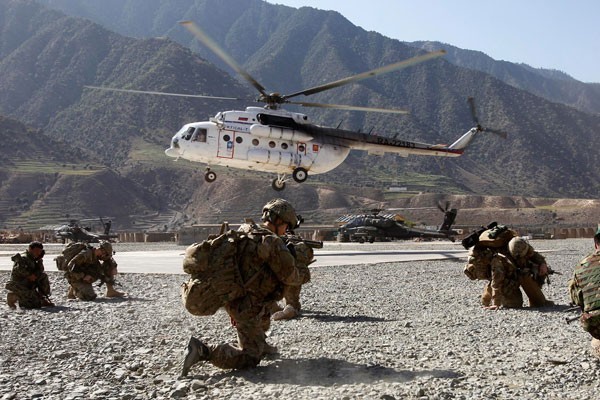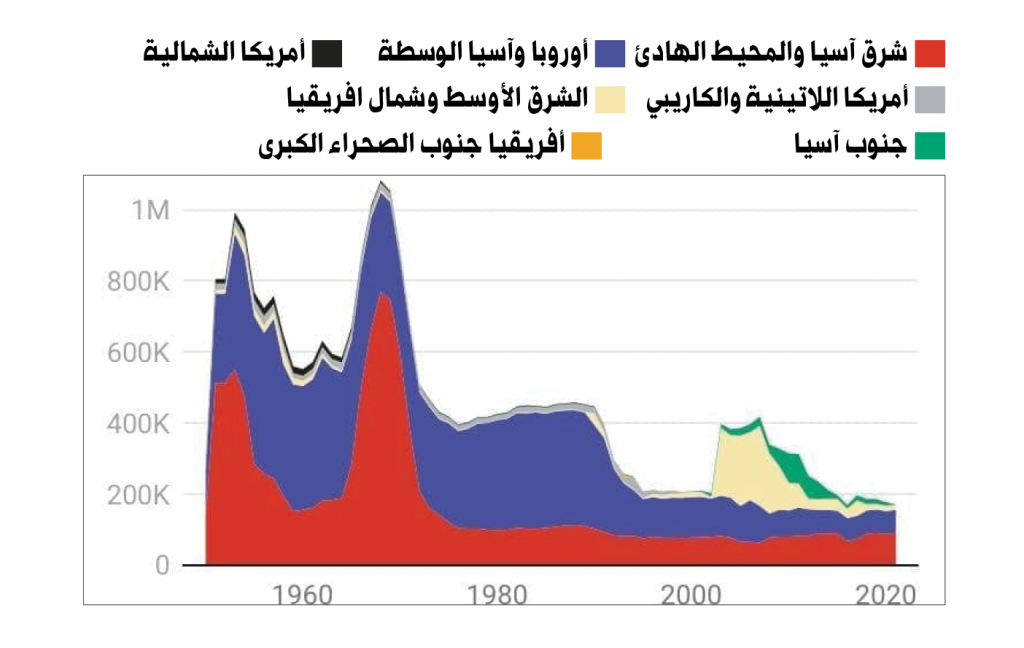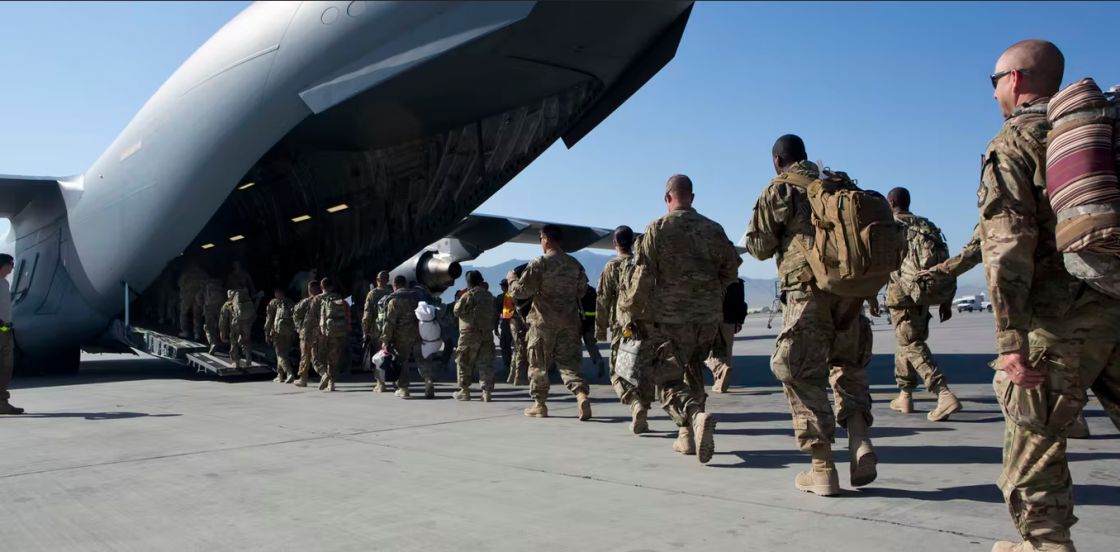- Articles
- Posted
At What Stage is the US Withdrawal Process, from the Region and from Syria? What to Do?
Talk in the media and politically about the US withdrawing its forces from certain parts of the world, particularly our own and Central Asia, has been noticeably on the rise for a little over three years.
Several years before that, away from the cameras and pens of the press, many think tanks and decision-making centers around the world had begun to predict this tendency towards withdrawal. In some cases, they started early on to formulate specific policies to contain that withdrawal when its time came.
Perhaps the most prominent example of that is what happened after US withdrawal from Afghanistan. At the time when the public opinion predictions, and a sizable portion of media analyses around the world, revolved around one basic idea, which is that the withdrawal in the form and speed in which they took place will lead to unleashing total chaos that would not stop at the borders of Afghanistan, but would extend beyond it to all its surroundings; many were surprised that all the governments in the neighboring countries to Afghanistan, starting with Pakistan, Russia, Iran, and China, had been prepared for this in advance and over many years. These countries had built long-term relationships with the Taliban and with other local forces within Afghanistan in such a way that they have thus far, with a reasonable measure of success, prevented the outbreak of all-out chaos, both inside Afghanistan and around it.
Decision Centers and Advertising Centers
What cannot be overlooked is that there is a time difference, in years and sometimes decades, between the time decision and action centers around the world realize the subsequent trends of development and actual work based thereupon begins, and the time those trends are realized.
What also cannot be overlooked is that the majority of “mass media” do not approach the major trends of development until a short time before or during their occurrence. In this sense, their actual function is not to form a true and comprehensive picture of what is happening and what can happen, but rather plays a specific, detailed role (and of course important) in managing the current battle. In many cases the primary role of “mass media” is to cover up the major actual trends. Perhaps the way Western media has dealt with the issue of the US withdrawal during the past few years is an exemplary and educational example in this regard.
The Boundaries of the Conflict
Trump’s announcement of withdrawing troops from Syria at the end of 2018 within the policy of “ending forever wars” represented the trigger for the first of several waves of talk about US withdrawal.
Since then, the US media has presented to us a “democratic” festival of opinions and counter-opinions about the withdrawal, between with and against, and between partially with and partially against. This make the overall picture seem as if there is an actual conflict within the American decision-making center about a foreign policy that Trump himself invented and surprised everyone with it. Everyone then had to think quickly and express their position from it.
This does not mean that there are no internal polarizations and conflict; they certainly exist. However, this conflict is in fact:
First: It is not a conflict over the general withdrawal trend imposed by the reality of the international conflict and the reality of the new international balance in light of the steady decline in the US’s capabilities and abilities.
Second: It is a conflict about the details, deadlines, and mechanisms, and not a conflict about the general trend.
Third: The goal of the media picture that is being presented for this conflict, which carries a great amount of exaggeration, and expands the spectrum of possibilities from complete and immediate withdrawal, to not withdrawing at all and even staying for many decades to come, is an attempt to mislead everyone, especially local sides that are usually characterized by shortsightedness and having naive mental images about reality and the possibilities of its development, as a result of looking at things through a regressive lens of their selfish interests.

The First, Second, and Third Media Waves
Look at what has happened since Trump’s 2018 announcement, we can identify a pattern or series of waves of talking about US withdrawal, with peaks marked by certain events or activity, followed by a period of media coolness on the issue.
Usually, the peaks of the waves are accompanied by some official American talk or indication of US withdrawal, followed by (official and unofficial) American commentary on the matter, denying what was initially said.
In parallel, partial or complete withdrawals have taken place these last few years, among them Afghanistan, partial withdrawal from Syria at the end of 2019, sweeping withdrawals from Iraq, and repositioning in some locations in Europe, including some like those in Germany.
On the occasions when admitting was inevitable, the function of mass media was to portray the retreat as progress and even an attack, through a repetitive binary: First: the areas from which the withdrawal is taking place are suddenly “unimportant” areas for the US, and even unimportant in general; and Second: the withdrawals are an offensive repositioning towards China.
As mentioned above, Trump’s announcement of withdrawing troops from Syria marks the first media wave of US withdrawal talk, which was on December 19, 2018. The second main wave was marked by the Iraqi parliament vote to expel US troops, on January 5, 2020. The third wave was less than five months ago, at the end of August 2021, with the US “sudden” withdrawal from Afghanistan, the images of which are still probably very fresh in everyone’s memories.
The Current Wave
Recently, there has been renewed talk about the American withdrawal and in the same manner, that is as an “internal” discussion, but that is published in media outlets going between two directions. One direction is that which is pushing towards withdrawal and the other towards staying. Interestingly, there has not been a significant actual event, at least not at the same magnitude or level of the ones mentioned above. However, there has been a sharp increase in attacks on US positions in Syria and Iraq since last summer, with few of them being widely reported. This is in parallel with the arrival of the legal deadline for the full withdrawal from Iraq on the basis of the Iraqi Parliament’s decision. This foretells that we will soon witness a new partial US withdrawal, from Iraq or Syria or elsewhere.
Even though these aforementioned attacks may not be publicized as much as any of the events of the first three waves we identified, they certainly reach and influence those within the decision-making positions and who formulate the withdrawal tactics. This has triggered responses somewhat similar to what we notice with each of the previous waves, mainly because some of the recent attacks have been reported and circulated (and contrary to usual) by some of the more mainstream media outlets (Newsweek, CNN, Wall Street Journal, etc.). This indicates preparations for imminent withdrawals.
An article published by The Conversation (US edition of an Australian media network), which was also published in UPI (an American news agency) last week, talked about “increasing international and domestic pressures against [the US’s] foreign military presence” and that “the scope of the US global military footprint has become increasingly contentious in Congress in recent decades and in some of the countries hosting US personnel”.
The article talked about how the US “will have to adapt to these increasing international and domestic pressures against its foreign military presence” and how alternatively “the gradual withdrawal from its overseas commitments will make it harder for the US to maintain its alliances and the international institutions it has crafted”.
One main idea is that the current US administration is trying to figure out how to decrease its military presence abroad without losing the benefits of being present on the ground, an equation that is proving hard to solve. The article also talks about the importance of US direct presence “if the US wishes to continue to influence regional politics and use its military as a credible deterrent to rival powers”. This indicates that the US is realizing that withdrawal inevitable and its main concern is how to make it as unharmful as possible to it.
More relevant to our region, an article in Task & Force (an online American outlet focusing mainly on defense issues) published two days ago titled “A nonsense policy is needlessly putting American troops at risk in Iraq and Syria”. The article talks about how the back and forth with attacks on US positions and responding to them could become a cycle of escalation, then advises that “rather than falling into the same cycle that has endangered the service members it was meant to protect, the United States can simply recognize the futility and unnecessary risks of its presence in Iraq”.
The article recognizes that the US presence in Iraq has to do more with Iran, despite using combatting ISIS as a pretext, and thus Iran cannot really be blamed for “defending what it views as a critical strategic stake”. A similar argument is made for Syria, concluding that “this mission isn’t an asset but rather a liability to US security”. The article also hints that a US withdrawal from the region would be beneficial to the nuclear negotiations with Iran. The article concludes with noting that “the U.S. can reorient its foreign policy away from the failed hegemony of the last decade and toward a diplomatic and commercial role in the region. The U.S. can get far more by doing far less”.
Interestingly, the day before, an article in the Jerusalem Post painted a picture exactly the same as the one that above article was denying would happen in case of US withdrawal. The article, titled “What will happen to Iraq when the US withdraws?” said that such a withdrawal would result in an ISIS resurgence, which would “give the Iranian backed Shia militias in Iraq a chance to justify prolonging their existence”. The other scenarios also involved Iran maintaining or increasing its influence in Iraq. This is interestingly exactly the opposite of the argument of the previous article with regards to what would happen if the US withdraws from Iraq and Syria.
Per usual, there have been no official statements on the attacks, and nothing about the subject of withdrawal. However, Robert Ford, a former US diplomat including an ambassador to Syria, wrote an article in Asharq Al-Awsat last week, titled “America Is Not Leaving the Middle East”. The article presents, as is usual of Ford, a very shallow reading of the situation in the Middle East and the US positioning therein, within a very limited timeframe, and ignoring many indicators -- of course this is intentional by the former diplomat, who does not even sound convinced by his own argument, but he says it anyway.
Ford concludes the article by saying “Of course, events in Asia, in Europe and with Iran will affect the future American military position in the Middle East. Will China and Russia have more influence in the region? Of course.” Interestingly, this in itself indicates that he realizes that the US cannot and will not maintain its presence and position in the region, but is at the same time adamant in his attempt to fool readers by the nonsensical argument about the US staying in the region.

Preliminary conclusions
The three main ideas from the sample articles discussed above are the following:
1- The only main way the US can extend its influence in the regions where it has military presence, is to maintain this presence, even if with fewer troops and less effectiveness.
2- The backup method that may or may not succeed is to manage the withdrawal so that it is as sudden as possible, and such that it creates and leaves behind chaos and quagmires, which deprive the opponents of benefiting from the withdrawal. It seems that the number of supporters of this idea has begun to dwindle after what happened in Afghanistan, and especially after what happened recently in Kazakhstan, as it became clear that even if media lies deceive some local forces and some backward regimes, they certainly do not deceive the main opponents, or even most of the governments and regimes that have a reasonable degree of realism in seeing things and do not live in the bubbles of their own dreams.
3- A continued American military presence in its full size is no longer possible as in the past, due to the retreat, and the partial stay and partial withdrawal is also no longer able to achieve enough hegemony, and above all, the “sudden” withdrawal only surprises fools who have no influence anyway. Therefore, the only option left is to accelerate the complete withdrawal, but in parallel with trying to use the remaining presence as a bargaining chip at the regional and international negotiating table.
What this means for Syria?!
If we look at what has been happening since at least late 2018, in terms of US presence and repositioning in the region, including withdrawals such as those from certain positions and bases, or the withdrawal from Afghanistan, we can see a continuous withdrawal process with the US retreat policy not just from our region but globally. While this is still moving slowly, it is moving steadily and speedily in a particular direction leading towards complete withdrawal.
While the withdrawal is inevitable, how it happens might vary depending on the more dominant side within the American establishment. So far, indicators point to dominance by the current that is trying to prolong the process as long as possible, thus prolonging attrition of the region and its peoples, not in the hope that the “sudden” withdrawal leads to “sudden collapse” and total chaos, but to the contrary, to have the withdrawal come after the total collapse becomes a reality.
This means for us, as Syrians, that the solution will not come with a qualitative American withdrawal. This is because such withdrawal of the US, as we mentioned above, will not take place until after a total collapse is surely achieved, and in the event that other bigger factors do not affect the global arena. However, we have to start from the worst-case scenario in making our plans.
This means several things, including:
1- The longer the US presence in Syria, the closer we are to a complete collapse of the state and society, including the risks of partition.
2- In addition demanding the exit of the Americans and all foreigners, actually removing them will not be achieved by waiting for some international or regional deal. Waiting today is the main American tool in achieving complete collapse. Their expulsion occurs through the actual start of a comprehensive political solution and the full implementation of UNSC Resolution 2254 by the patriotic Syrian and under pressure from patriotic Syrian, in cooperation with the international sides who have an interest in ending the quagmire, led by China and Russia, not regardless of the American will, but rather opposite to it.



